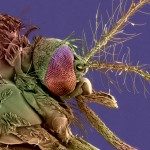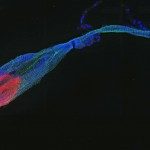Lien vers Pubmed [PMID] – 25442218
Parasit Vectors 2014;7:544
BACKGROUND: The identification of mosquito vectors is generally based on morphological criteria, but for aquatic stages, morphological characteristics may be missing, leading to incomplete or incorrect identification. The high cost of molecular biology techniques requires the development of an alternative strategy. In the last decade, matrix-assisted laser desorption/ionization time-of-flight mass spectrometry (MALDI-TOF MS) profiling has proved to be efficient for arthropod identification at the species level.
METHODS: To investigate the usefulness of MALDI-TOF MS for the identification of mosquitoes at aquatic stages, optimizations of sample preparation, diet, body parts and storage conditions were tested. Protein extracts of whole specimens from second larval stage to pupae were selected for the creation of a reference spectra database. The database included a total of 95 laboratory-reared specimens of 6 mosquito species, including Anopheles gambiae (S form), Anopheles coluzzi (M form), Culex pipiens pipiens, Culex pipiens molestus, Aedes aegypti and 2 colonies of Aedes albopictus.
RESULTS: The present study revealed that whole specimens at aquatic stages produced reproducible and singular spectra according to the mosquito species. Moreover, MS protein profiles appeared weakly affected by the diet provided. Despite the low diversity of some MS profiles, notably for cryptic species, clustering analyses correctly classified all specimens tested at the species level followed by the clustering of early vs. late aquatic developmental stages. Discriminant mass peaks were recorded for the 6 mosquito species analyzed at larval stage 3 and the pupal stage. Querying against the reference spectra database of 149 new specimens at different aquatic stages from the 6 mosquito species revealed that 147 specimens were correctly identified at the species level and that early and late developmental stages were also distinguished.
CONCLUSIONS: The present work highlights that MALDI-TOF MS profiling may be useful for the rapid and reliable identification of mosquito species at aquatic stages. With this proteomic tool, it becomes now conceivable to survey mosquito breeding sites prior to the mosquitoes’ emergence and to adapt anti-vectorial measures according to the mosquito fauna detected.


